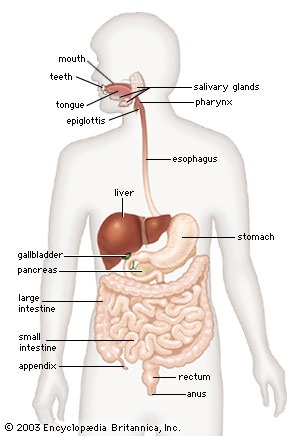gastroenterology
pathology
 medical specialty concerned with the digestive system (digestive system, human) and its diseases. Gastroenterologists diagnose and treat the diseases and disorders of the esophagus, stomach, intestines (intestine), liver, biliary tract, and pancreas. Among the most common disorders they must deal with are gastroesophageal reflux disease (GERD), gastric and duodenal ulcers, malignant tumours, inflammatory bowel diseases, colorectal cancer, and rectal disorders.
medical specialty concerned with the digestive system (digestive system, human) and its diseases. Gastroenterologists diagnose and treat the diseases and disorders of the esophagus, stomach, intestines (intestine), liver, biliary tract, and pancreas. Among the most common disorders they must deal with are gastroesophageal reflux disease (GERD), gastric and duodenal ulcers, malignant tumours, inflammatory bowel diseases, colorectal cancer, and rectal disorders.The first scientific studies of the digestive system were performed by Jan Baptist van Helmont (Helmont, Jan Baptista van) in the 17th century. In 1833 the publication of William Beaumont's (Beaumont, William) observations shed new light on the nature of gastric juice and the digestive process in general.
A major advance in treatment in the 19th century was the use of gastric lavage (washing out of the stomach) to treat stomach poisoning; this became a standard treatment for all forms of gastric irritation, and the long tube used to introduce the lavage fluid was also adapted to view the stomach for diagnostic use. A tube that could be inserted down the esophagus and upon which a light was mounted to illuminate the area visualized was invented in about 1889; this rigid instrument was soon replaced by the semiflexible gastroscope, developed by Rudolf Schindler in 1932, and then by the flexible fibre-optic gastroscope, developed by Basil Hirschowitz in 1957. In the 1890s Walter Cannon (Cannon, Walter Bradford) used X rays to visualize the stomach and digestive organs, and he also used bismuth salts to coat the gastrointestinal lining and thus make digestive movements visible by fluoroscopy.
- Clyde Beatty
- Clyde Fitch
- Clyde K.M. Kluckhohn
- Clyde McPhatter
- Clyde (of Clydesdale), Colin Campbell, Baron
- Clyde, River
- Clydesdale
- Clyde Vernon Cessna
- Clyde W. Tombaugh
- Clyfford Still
- Clynes, John Robert
- Clytemnestra
- Clères Zoological Park
- Clément Ader
- Clément Janequin
- Clément Juglar
- Clément Marot
- Clément Pansaers
- Clérambault, Louis-Nicholas
- Clüver, Philipp
- C.M.G.
- C.M.G. Lattes
- C.M. Kornbluth
- cnidarian
- cnidosporidian